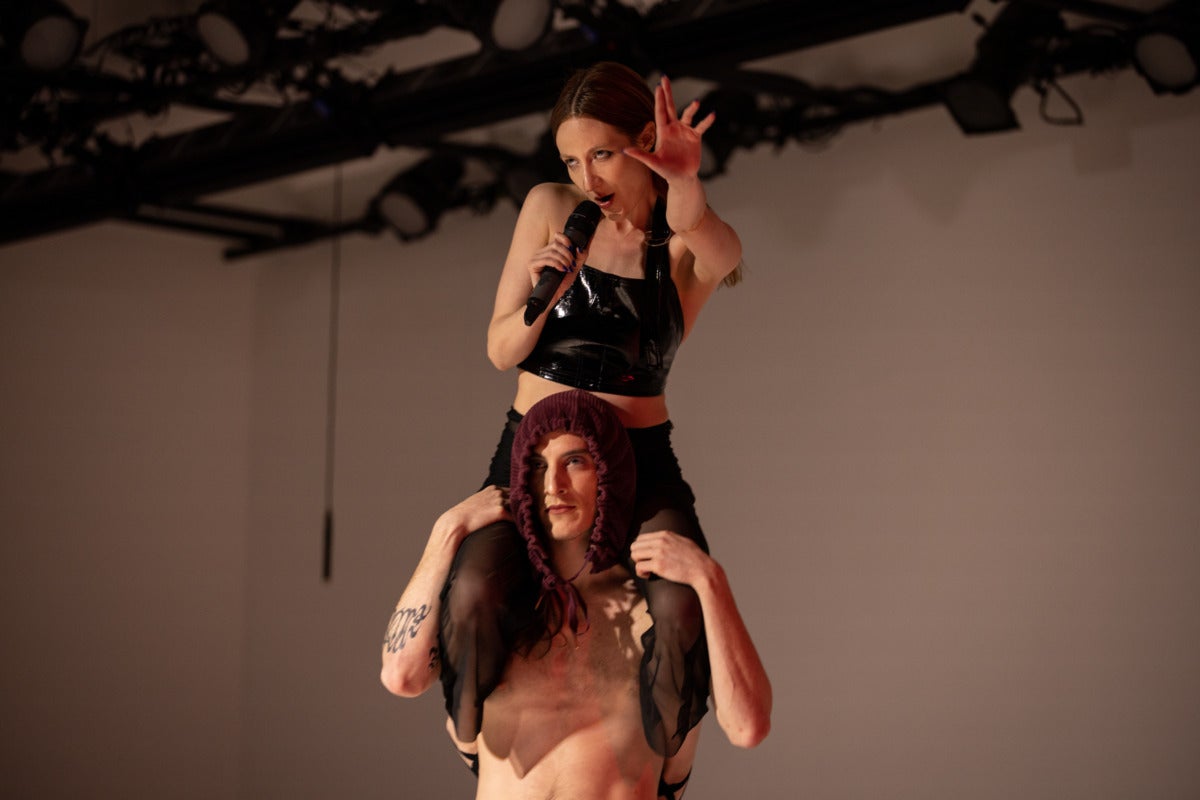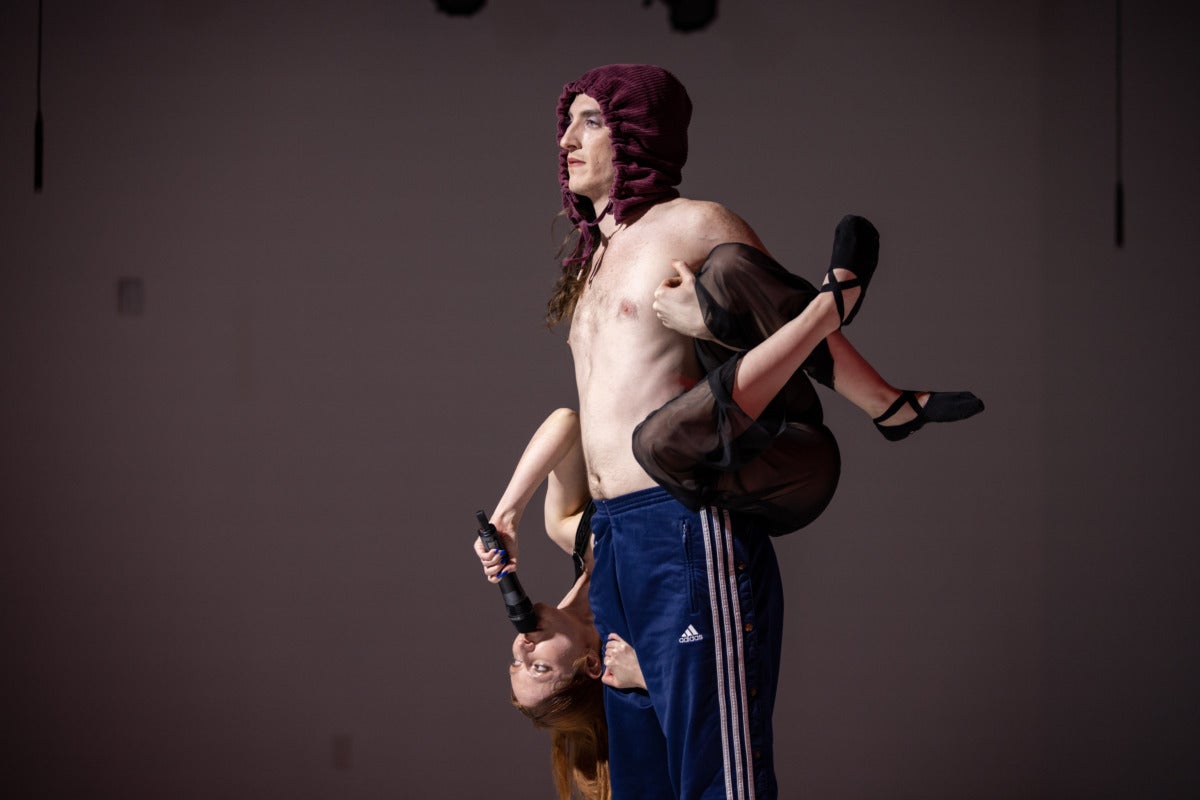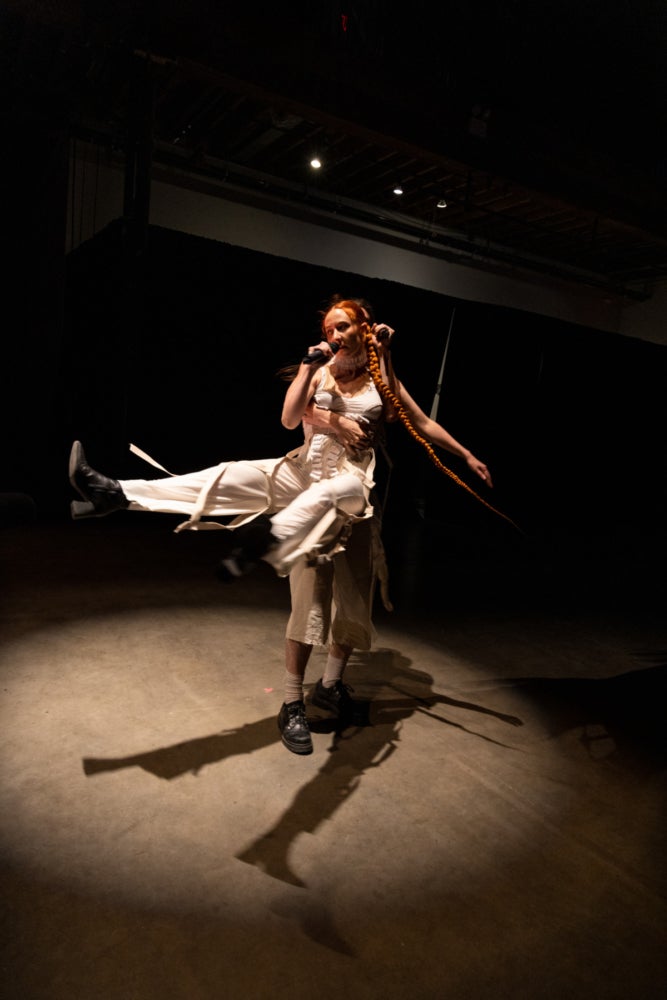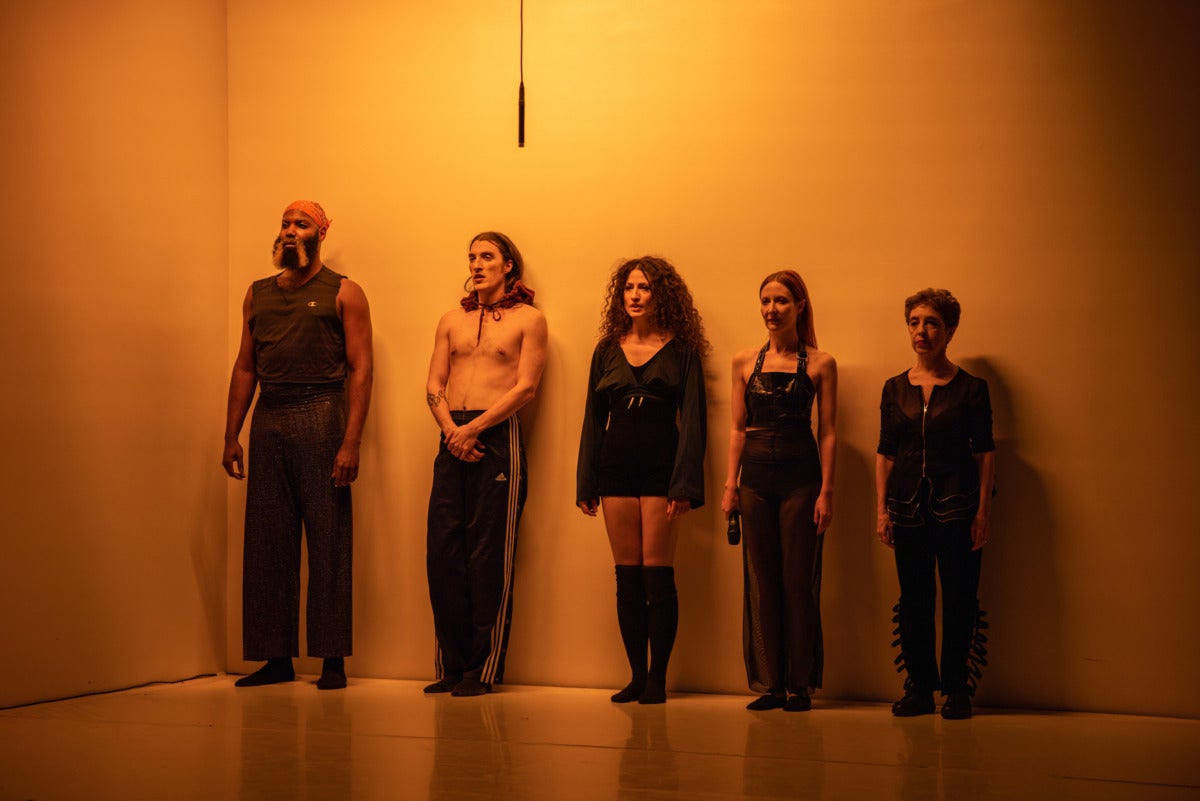
Kinlaw, the North Carolina born, Brooklyn based artist, uses choreography, sound, and sculpture to create installations focused on empathic potential. Ahead of their performance at ICA VCU as part of the ongoing experimental performance program Test Pattern, I was able to meet with Kinlaw over Zoom to discuss their upcoming performance, entitled Circuit 3.
___
Kat Eaves: With your upcoming performance with ICA at VCU, as a part of their series Test Pattern, what is the beginning of your process for something like that? When given such an open space with a broad theme to address to you begin with music, or movement, or a goal?
Kinlaw: Lately, I’ve started with learning and curiosity as something that helps me figure out what I want to be doing for these commissions. I’ve been wanting to learn more about machines, motors, electricity. Visualizing rhythm, in a more musical sense, I’ve been wanting to learn more about how I work as a sculpture artist and how I bring together sound and movement in that world.
For this commission it’s the next step after a new project I started over the summer that was filled with a lot of questions and curiosity. Before I know anything I really like to talk to the people involved. I like to see who is on the team, what the space looks like, are the chairs fixed in the space? You know, I really like to see what’s there first.
KE: I know as a choreographer collaboration is important to your work. ICA being in Richmond, are the people you’re working with from the area and is the place where you are giving the performance significant to the content of your performance?
K: Yes, it is significant to me. I think, not even from a collaborative standpoint, people’s time is meaningful to me. People arriving and watching, participating, or asking questions means a lot. Even if someone comes to something just as a viewer, I really try to consider where they are sitting, what they see, and their time. Whenever I go anywhere, I really try to allow myself the space to take everything into consideration.
But I pivoted for this project. I was going to have a cast. There was going to be some cast that came with me from New York and some cast that I would meet and work with that were local [to Richmond] and that was something that I was really into and was a format that I’d used before. But I decided a handful of weeks ago that I was going to make this a solo performance and give myself the time to work in the space and to experiment without having to work with other people in that way.
It’s a change for sure, but it’s cool because my attention is going to go more towards the technical team who is there – who are skilled, and really interesting, with lighting, sound, media. It’s a different kind of collaboration, not like choreography in a performance sense, but the tech team and the curator and the people at ICA VCU are very cool and very skilled and now I’m giving myself more space and time to work with them without distraction.
KE: I saw recently you’ve been using a few different microphone techniques, and projection in your work. Has technology been a major part of your previous work or is this a new experiment?
K: To be honest with you, I don’t feel very techy. It feels simple. It may not look like it – I have a way of making it look not as minimal as it may be – but I am proud of how I work with basic objects and twist them, or to give them new roles. I’ll be working with these mobile feedback machines using mics and exile cables. Working with feedback and rhythm and speed, building more of them, and putting them around the space. I’m excited.
KE: I mentioned to you earlier that I was a big fan of your album The Tipping Scale. Do you see a difference in your recorded music, an album that solely exists as audio for some, compared to your live performances and even your music videos? How do they all function in relation to each other?

K: The answer is I don’t know, and I think that’s good, because with everything, the record, visual work, choreography, the ICA VCU performance, things I’m working on this month that you might not know about yet, it really comes down to this meeting point between sound, movement, and psychology. I feel available to letting myself explore all different types of mediums as long as I feel like I’m touching this thing that fascinates me.
The album, the videos, the first thing that comes to my mind is the teams that I work with for each of these things and how distinctly special they are. They are indeed in different categories that then go into different parts of the world. With performance – a lot of the time I create performance and they come see it and we experience it together, where with the record this idea of making and then giving is so different than what I’m used to. Making something and then giving it away and letting it live beyond a room is fun and challenging for me, and that’s why I’ll keep making them. I’m trying to have these important and fun experiences with different creative people who may ask the same type of questions that I do and then be on to the next thing.
KE: I love the way you said “giving away” your album, because it is something that exists permanently now, and isn’t changing. With performances, viewers are arriving to experience something ephemeral. Everyone is confronting it differently from their literal vantage points, but also from their own emotional vantage point. For this upcoming solo project, how do you see your audience as collaborators? How do you plan to interact?
K: This is really an installation that has a performance that flirts with ideas of how you might alter the installation. Then it goes into three parts because there is a talk afterwards. It’s traditional in the sense of certain institutions – a stage performance, an installation, and then a talk back.
There are some preset ways that people can engage with what this [the installation and performance] is because it’s not so wildly experimental. The installation is designed to be something that people can play with. It’s designed for people to be afraid of – but also to be playful with, which is exactly the intersection that I love! I think that the actual perspective, or distance, to which you are viewing something matters for this one and I will encourage people to walk through it.
KE: I would love to hear you talk a little bit about kinesthetic empathy. From my understanding it’s the way that an audience member can feel like they are participating in the movements that you are doing. Can you talk a little bit more about that phenomena and how you achieve that in your performances?
K: I work vigorously in psychology and neuropsychology. I really enjoy science and physics and I enjoy perspectives. I try to keep the work that I do open enough to allow for human, primitive responses, reactions, and behaviors. And that’s what I look for when I work with other people.
I think that I got into this early on in my science life. I started looking more into mirror neurons. I was reading about them, I was like oh shit! I bet you that’s why I like doing what I’m doing. It’s like what you said before it’s this primal feeling that you get when you watch someone go through something and thus you also can have empathy for that action because you feel as though you’re in some way going through it too.
It’s just a hope or an assumption that I achieve anything from my performances. I think that’s great. This idea of presenting something and letting it be open enough so that people can have their own experience, but hopefully having it be this psycho physical thing that people go through. It’s not for me to direct it in any which way but I would like to create a situation where people can feel.
It’s designed for people to be afraid of – but also to be playful with, which is exactly the intersection that I love.
KE: On Test Pattern’s description of your performance, they mention your exploration with memory. Is that something that you’re working on for this project?

K: Yep. Everybody has different associations with their memory and how they identify with their past and how they behave. People have different ability to recall visual memory, episodic memory, sights, sounds. A big part of my personal life is that I really didn’t remember anything. In my twenties – and even my thirties – there are blocks of time I can’t recall.
But I was still responding in tandem with these memories. I had certain things I hated, and I loved and that made me feel upset. I put myself in therapy. I started to research those things and it’s important for me to delicately connect them. They feel like these little cobwebs that connect me underground to the past and they must stay delicate and flexible. This idea of memory, and how the physical body can sometimes remember before I can, keeps me in awe of being alive. There are a lot of things out there that shoot us down, but one thing that I do have faith in is sensations and trying to figure them out.
KE: That’s very interesting. One of the best ways I’ve heard it described is by the poet Mark Doty who said memory is like the center of a spiral staircase and as you go up and around you gain different perspectives. The memory is there and it’s the same, but you are the thing that is in flux and recollection through sounds, smells, and more tactile things is what changes.
K: Yes, that’s interesting. The spiral staircase makes me think of availability. When I’m available to remember things or when I’m not and why that might be and what are the different entry points. For me, I trust in some way that my body wants to be alive above all else. It wants to be alive and wants to keep going and has all these tricky mysterious ways to keep me going forward. As I think about walking down this spiral staircase, I think of the different doors that might be open. And one door might have light spilling out and one door might be a dinner party with lots of friends that make me feel special and loved and the next one might have a song blaring. As you’re walking there can be these little doorways into the core thing.
I think that’s distinctly why I work the way I do. You mentioned the album, the videos, that’s me on the staircase! It’s all the same thing but to deny these different modalities – its human to have these different entry points. It’s not always socially encouraged but it’s the way that we are, holistically, to have different ways that might help us get to the thing.
KE: You are from North Carolina. Does your being born and raised in North Carolina come out in your work, and how so? Is there a North Carolina-ness to your work?
K: HELL YEAH BABY! There is a North Carolina-ness that comes out when I have a glass of wine. Yes, but I moved to the city in 2005 so I’m kind of split down the middle. But I think that where I come from is where I come from. There isn’t a distinct homage, but I certainly do live in a way that honors my parents and loves them. Even though they have no idea what I’m doing with my life half the time, I still think about them and how I relate to them. I create work based on how it feels to be a part of our constellation. In that way I do incorporate North Carolina – but as a place it could be anywhere.

There definitely is specificity in how we all grow up and where we grow up, what kind of neighborhoods we lived in, if people picked on us. My history is certainly the lens in how I see everything. Which I think is a lot of what we’ve been talking about.
Also, this era of work I’m doing feels more like my dad than anything I’ve ever done, which is fun. It’s a lot of me working in the wood shop or the metal shop and figuring out how to discover different types of motors. This is fully my dad’s area. He’s built houses his whole life and my dad would probably be better at building this installation than I would which I think is fantastic. So that part of it is fun for me, it feels very good.
KE: I’m curious if you could talk a little bit about what the sounds of choreography are and how you plan to do that?
K: Yeah. Choreography not looking like counts in a traditional or rigid sense but trying to create this apex or home for finding information. It’s like that same staircase – for me an example would be a week ago I was out, and I felt uncomfortable and I started going like this:
[ Kinlaw holds up their hand and taps their fingers together rapidly ]
and I didn’t notice it until later but that would be an example of the gesture happening first. “Oh, I’m doing this thing I must feel pretty nervous.”
What this work does is play with gestures, behaviors, and making them musical – whether that’s by hanging mics from the ceiling or having microphones placed on my body or in some cases also mic-ing the floors. So, what can authentically start as a tap can then become an integral part of a score. You can use movement to create sound.
That’s what I’m playing with here in this upcoming installation. A big part of this feedback system is the age-old relationship between a microphone and a monitor. But when you put the monitor on wheels or you cover it with your body or you drape it with something, that monitor becomes less available. There is this beautiful play with moving things around in space, how available are they how unavailable all they, and how does it change the sound. There is a lot I can say about this whole miking of gesture and choreography, and why I do it, but that’s just a little bit.
KE: Let me ask you the question Test Pattern presents to us. “Is it possible to reclaim the transformative potential of alternative media?” And how does your work fit in to all of this?
K: Yes. Strong YES! Yes, you can underline and bold that. There is a lot of potential for us to feel better than we do, at least I hope so. I think we can do this through being together. Do I think I fit into that curatorial pocket? Yes. In some ways, I am contributing to this media overload, and I can both be at odds with it and a participant at the same time. I think that’s good to see. I overload people as well. I don’t feel that not working is the answer, but I do think, that an awareness, responsibility, and honesty throughout process can be ways to continuously reclaim why art, or gatherings are important.
I really like dinner parties! They feel undeniably important to me. Getting together, sometimes there is the lead, a chef, sometimes we are collaborating and all bringing dishes. At the end of the day, it generally feels pretty nice, and I think that dinner parties are a great model for why getting together and making things, or having a focused theme, can be really nice. So, if my work can feel anything close to a good dinner party that’s good. I like that.
I haven’t stopped asking myself: “Why does this matter? What am I contributing to? Who am I taking away from? Why? Does this have value? What value? Why?” I don’t always know but I am asking, all the time.
Become a member or make a tax-deductible donation below.




